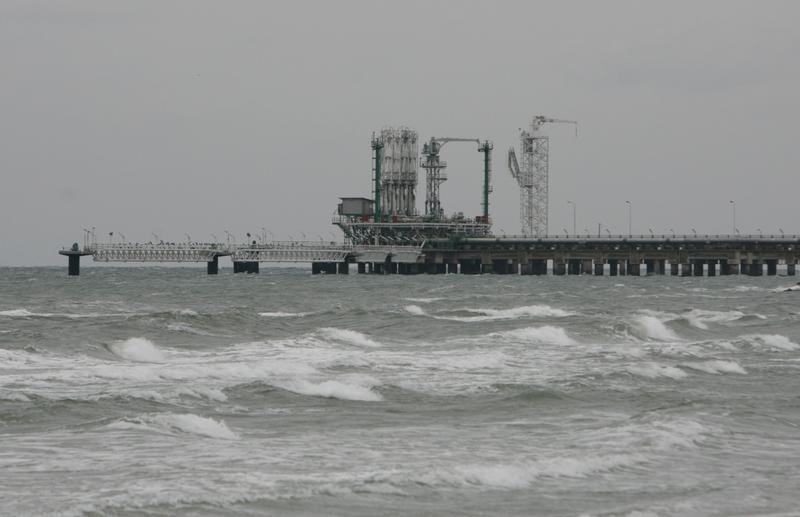(Repeats with no changes to text)
By Clyde Russell
LAUNCESTON, Australia, Jan 18 (Reuters) - - In contrast to
the carnage in crude oil markets, liquefied natural gas (LNG)
prices in Asia have enjoyed relative stability for the past
three months, but it's unlikely the calm will persist much
longer.
Spot Asian LNG prices LNG-AS ended last week at $5.60 per
million British thermal units (mmBtu), about 28 percent below
the recent peak of $7.80 reached on Nov. 22.
In contrast, Brent crude oil LCOc1 has dropped 46 percent
from its recent peak in early October to trade currently around
$28.55 a barrel.
The relative outperformance of spot LNG holds over the
longer term as well, with the price of the super-chilled fuel
having dropped 68 percent since its all-time high of $20.50 per
mmBtu in February 2014.
Brent has declined by 75 percent since its 2014 closing peak
of $115.06 a barrel, reached on June 19 of that year.
While both markets would appear to suffer from excess supply
and less than stellar demand growth, what appears to be
happening is that LNG is currently trading with a lag to crude.
The reasons for the decline in oil appear well understood by
the market, even if the current drop below $30 a barrel is
viewed as unsustainable for an extended period given the amount
of global production that will be loss-making.
Oil markets have been oversupplied since the decision by top
exporter Saudi Arabia not to balance the market by cutting
output, but rather to let low prices eventually drive out
higher-cost producers.
The return of at least 500,000 barrels per day of Iranian
crude in the short term after the lifting of Western sanctions
is also putting a dampener on oil prices.
But the outlook for LNG in 2016 looks just as bad, if not
worse, than that for crude.
The oversupply in LNG, particularly in the Asian region, is
set to increase dramatically in the next few months as new
projects in Australia ramp up.
The 9 million tonnes-a-year Australian Pacific LNG project,
co-owned by ConocoPhillips (N:COP) COP.N and Origin Energy ORG.AX ,
shipped its first cargo on Jan. 9, becoming the third coal-seam
gas to LNG plant to start operating in Australia's Queensland
state in the past year.
On the other side of Australia, Chevron (N:CVX) CVX.N said it's on
track to export its first cargo early this year from the 15.6
million tonnes-a-year Gorgon venture, the world's most expensive
LNG project with an estimated cost of $54 billion.
And it's not just Australia that's flooding the market with
new LNG, shipments from the United States are coming in the next
few months as well.
U.S. SHIPMENTS DELAYED, STILL COMING
While the first cargoes from the lower 48 states have been
delayed, the point is that by late February or early March it's
likely that Cheniere Energy Partners CQP.A will join the
global LNG supply boom with exports from the first train of six
planned at its Sabine Pass project.
While Sabine Pass is the only U.S. LNG plant scheduled to
start this year, four more are currently under construction.
Australia also has two more conventional LNG projects under
construction, which are due to start output later this year, and
Royal Dutch Shell's RDSa.L Prelude floating LNG project,
which is slated to start operating next year.
In total, the new Australian projects started in the past 12
months and those expected to commence shipments in the next 12
to 18 months will add 61.8 million tonnes of capacity, while
plants under construction in the United States could add 72
million tonnes by 2020.
The demand for LNG looks certain to be unable to keep up
with the additional supply coming, meaning that prices will
likely have to fall to incentivise coal-to-gas switching in top
Asian consumers Japan, South Korea and China, as well as in
Europe.
Global demand will grow by 23 million tonnes in 2016,
according to consultancy Energy Aspects, but only 7.1 million
tonnes of this will be in Asia.
If this is the case, it's logical to expect that the flood
of Australian LNG will force spot Asian prices lower, as well as
displacing Qatari LNG cargoes from the region.
This means more Qatari shipments will likely head to Europe,
competing with the nascent cargoes from the U.S. Gulf coast.
Overall, it appears likely that LNG's period of calm
relative to oil is poised to end, and spot prices should decline
to at least match the plunge in crude, or perhaps even exceed
it, especially as the lower-demand shoulder season starts with
the end of the northern winter around March.
(Editing by Joseph Radford)
